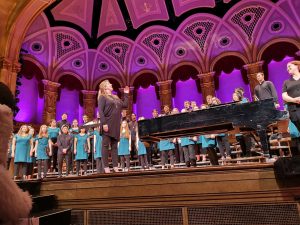On March 15, 2019, I had a chance to listen to the UBC Symphony Orchestra performance at the Chan Centre for the Performing Arts. This was the first concert I attended at the Chan Centre, so I was looking forward to the performance. The two music pieces A Northern Suite by John Luther Adams and La Mer by Claude Debussy were composed to depict exciting characteristics of the wild nature. Clarinet Concerto by Jean Francaix, on the other hand, showcased something more abstract and complex.
John Adams is known for his compositions focused on the love of nature. A Northern Suite consists of five movements, each depicts a particular scene in nature. The main theme of these five movements painted a picture of a ride through the mountains full of exciting natural sounds. The first and third movements were imitating the bird voices through higher range instruments that were supported by bass instruments. The second, third, and fifth movements had a more solid sound; I believe to describe the density of earth layers in the mountains. I could not follow steady rhythm patterns throughout the performance; my guess is that the author did that to recreate an unpredictable character of nature.
Clarinet Concerto by Jean Francaix performed by Carlos Savall-Guardiola (clarinet) was a very technically complex piece. It consisted of four movements Allegro, Scherzando, Andantino, and Allegrissimo. The beginning of the first movement was quite cheerful. The flute played the main theme, which is then imitated by clarinet, and then by the full orchestra. Later on, the complexity of this composition increased; Carlos played quick legatos exceptionally well, showing his mastery in playing the clarinet. The second movement was in triple meter and was perfect for the waltz dance. The clarinet introduced the main theme and repeated parts of it throughout the performance adding technically complex arpeggios. The second movement was quite playful and at times abrupt. The third movement started with clarinet playing scales in a minor mode. The tempo of this movement was much slower compared to the previous movements. Clarinet Concerto is an exceptional piece, which requires high technical ability due to quick passages throughout the piece.
Since his childhood, Claude Debussy was interested in sailing and exploring seas. La Mer describes three distinct portraits of the sea, using the full potential of an orchestra to imitate its sound. The first movement From Dawn to Noon on the Sea started very slowly and increased in its tempo and intensity closer to the middle and the end. I think he wanted to describe a calm sea at the dawn, which get disturbed and becomes wavier by noon. The second movement Play of the waves was quite upbeat, which perfectly represented playful waves of the sea. I noticed that Debussy continuously used the percussion instruments in order to imitate the waves’ movements. The third movement Dialogue of the Wind and the Sea started off slowly to increase in its intensity as if the wind and the sea had a lively conversation with each other.

